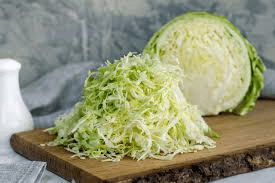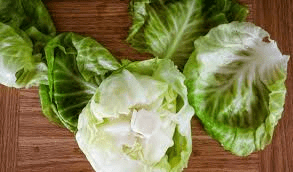If you haven’t eaten cabbage in a while, we urge you to look again at this healthy, unsung hero of the vegetable world. Want beautiful skin, to lose weight, a great immune system? See five great reasons to eat (and grow) cabbage!
5 Reasons to Enjoy Cabbage
1. Cabbage offers huge health benefits that can not be ignored: Many health benefits are similar to broccoli (they’re in the same plant family). Cabbage is high in beta-carotene, vitamin C and fiber. (Vitamin C to reduce toxins which are the main causes of arthritis, gout, and skin diseases.) Also, cabbage may reduce the risk of some forms of cancer including colorectal cancers.
2. It’s cheap and widely available year-round: There are so many varieties of cabbage, too, including Green, Savoy, red, Napa, bok choy, and Brussels Sprouts (tiny cabbages!). It is possible to enjoy eating cabbage pretty much all year round.
Although most any cabbage will work for any use, plant breeders have developed many varieties in many colors and textures. Some are sweet, mild, tender as lettuce; others rock hard and good for shredding or slicing crosswise into thick steaks for roasting.
3. Cabbage lasts longer in the fridge than most vegetables: If cabbage is properly stored, it can last from 3 weeks to up to 2 months in your refrigerator. In optimum root cellar conditions, it can even last longer. Store in a hydrator drawer if possible. Do not remove the outer leaves nor wash until ready to use.
4. It’s versatile: I’ve sliced it into soups and salads, shredded it into coleslaws, stir-fried it with onions and apples, fermented it into sauerkraut, stuffed whole cabbages or individual cabbage leaves, steamed it, boiled it, fried it, roasted it, and grilled it. I’ve even experimented with cabbage desserts, not always successfully! (See more about cooking below.)
5. Cabbage is even great for weight loss and beautiful skin: I’m sure you’ve heard of the cabbage diet (not that I would recommend it). There are only 33 calories in a cup of cooked cabbage, and it is low in fat and high in fiber. Cabbage also helps keep skin looking health, toned, blemish-free and glowing; it’s rich in antioxidants (including vitamin C and beta-carotene).
Read Also: The Complete Classification of Crops
Tips for Preparing Cabbage

Even though the inside of cabbage is usually clean since the outer leaves protect it, you still may want to clean it. Wash whole cabbage head under running water or remove the thick fibrous outer leaves and cut the cabbage into pieces and then wash under running water.
We recommend washing cabbage just prior to eating or cooking in order to help decrease the rate of deterioration. To cut cabbage into smaller pieces, first quarter it and remove the core. Cabbage can be cut into slices of varying thickness, grated by hand or shredded in a food processor.
The Nutrient-Rich Way of Cooking Cabbage
From all of the cooking methods we tried when cooking cabbage, our favorite is Healthy Sauté. We think that it provides the greatest flavor. Healthy Sauté similar to Quick Boiling and Quick Steaming, our other recommended cooking methods follows three basic cooking guidelines that are generally associated in food science research with improved nutrient retention.
These three guidelines are: (1) minimal necessary heat exposure; (2) minimal necessary cooking duration; (3) minimal necessary food surface contact with cooking liquid.
However, in some recent studies on cabbage cooking, different cooking methods have been found to produce differing results. For example, when 5-minute boiling was compared to 5-minute streaming, 5-minute microwaving, and 5-minute steaming, boiling came out better than either steaming or microwaving for preserving the anthocyanins in red cabbage. For retention of vitamin C in this same study, however, steaming came out best.
Fermentation of raw cabbage has also been shown in several recent studies to provide some health benefits that heat-based cooking methods cannot. For example, fermentation of cabbage has been shown to result in increased formation of ascorbigen, a well-documented antioxidant formed by the interaction of vitamin C (ascorbic acid) with indole-3-carbinol (I3C). I3C is the isothiocyanate that can be made from glucobrassicin, one of the glucosinolates present in cabbage.
The creation of ascorbigen through cabbage fermentation has further been shown to improve oxidative stress and antioxidant capacity in several animal studies.
Finally, several recent studies have point out that raw cabbage can offer greater amounts of certain nutrients that either cooked or fermented cabbage. In one study, the incorporation of fresh, uncooked, chopped red cabbage was recommended as an optimal way to derive nutritional benefits from this cruciferous vegetable.
Slicing Cabbage very thin before cooking and letting it sit for 5-10 minutes helps bring out their hidden flavors and makes them more enjoyable. You can start to smell the complex rich aroma after you cut it.
Read Also: Nutritional Profile and Introduction to Food Rating System Chart of Cabbage
This is similar to the reactions that occur that causes the pungent smell when onions and garlic are cut, although the smell is not quite as intense For more on how preparation methods may impact the benefit of cruciferous vegetables.
To Healthy Sauté cabbage, heat 5 TBS of vegetable broth, chicken broth, or water in a stainless steel skillet. Once bubbles begin to form add shredded cabbage, cover, and Healthy Sauté for 5 minutes. For great Mediterranean flavor, transfer to a bowl and toss with Mediterranean Dressing. Ginger is a great addition to your Healthy Sautéed cabbage; you can also add rice vinegar and sesame seeds.
How to Enjoy your Cabbage

A Few Quick Serving Ideas
- Braise red cabbage with a chopped apple and red wine. This is a child-friendly dish since the alcohol (but not the flavor or the flavonoids) will evaporate.
- Combine shredded red and green cabbage with fresh lemon juice, olive oil, and seasonings such as turmeric, cumin, coriander, and black pepper to make coleslaw with an Indian twist.
WHFoods Recommendations on Preparing Cabbage
In case, you will want to include cabbage as one of the cruciferous vegetables you eat on a regular basis if you want to receive the fantastic health benefits provided by the cruciferous vegetable family.
At a minimum, we recommend 3/4 cup of cruciferous vegetables on a daily basis. This amount is equivalent to approximately 5 cups per week. A more optimal intake amount would be 1-1/2 cups per day, or about 10 cups per week.
Traditional methods of steaming or boiling make cabbage watery. Traditional methods of steaming or boiling make cabbage watery. To avoid this result and promote optimal flavor, we recommend Healthy Sautéeing cabbage.
Slice cabbage into 1/8-inch slices and let sit for 5 minutes to enhance its health-promoting benefits before cooking. For more details see the Nutrient-Rich Way of Cooking Cabbage below.
Read Also: The Ultimate Step-by-Step Guide to Vegetable Gardening
How to Cook Cabbage
Sadly, many folks think cabbage as smelly, but blame the cook, not the cabbage. This odor is the result of overcooking. If you make the common mistake of overcooking cabbage, I urge you to try again! Do NOT overcook cabbage! The longer the cabbage is cooked, the more smelly it becomes.
If boiling cabbage, cook very briefly, just until tender. Do not cook cabbage in aluminum pans; use stainless steel pots and pans. Finally, it helps to add a few drops of vinegar while cooking or wipe the inside lid of the pan with vinegar. Or, try steaming wedges of cabbage for 5 to 7 minutes. Top with butter and a pinch of salt and pepper or even with grated cheese.
Another idea is to sear cabbage by heating it in a very hot pan with a little bit of olive oil and butter (and a pinch of salt) until the cabbage wilts. Or, try roasting cabbage. Get the roasting pan really hot in the oven, and then put wedges of cabbage (tossed in olive oil and a little salt), and roast until slightly caramelized.
Cabbage is wonderful added to sautes and stir fries. It tastes great alongside peppers, onions, etc. Cabbage is also great in a coleslaw. Chop finely or shred and then toss with shredded carrots and green onions. Add any other vegetables that you would like. Toss with a yogurt/mayonnaise dill dressing or a vinaigrette. Large cabbage leaves can replace a tortilla for light and summery wrap sandwiches.
Top 10 Ways to Enjoy Cabbage

1. Just Drizzle and Enjoy: Cut up any type of cabbage, drizzle it with lemon and add a little salt for a mid-day snack.
2. The Healthy Reuben: Use low-fat Thousand Island dressing, rye bread, reduced-fat Swiss cheese, butter flavored nonstick cooking spray and deli slices of turkey instead of high-fat chipped beef.
3. A Prime Pasta: If pasta is for dinner, increase your vegetable intake by tossing some thinly slice cabbage into your sauce.
4. A Not-So-Typical Coleslaw.
5. Stir Fry: Cabbage has a mild taste and can be added to any stir fry.
6. Cabbage Casserole: Never tried cabbage rolls? You’ll be sold! They’re your favorite? Excellent! Then try them in a new way … check out our unique Cabbage Roll Casserole recipe.
7. Add Crunch to Your Lunch: Add extra crunch to your salads, soups, wraps, or sandwiches by topping them off with thinly sliced cabbage.
8. Slow-Cooked: Pump up the veggies on your hamburgers by adding slow-cooked cabbage, lettuce, tomatoes, pickles and light mayo.
9. Golumpki: A Polish Tradition: Mix spices with beef or pork, separate into small balls, wrap in cabbage and bake at 350 degrees for 1 hour.
10. Saint Patty’s Day: Keep the Irish tradition alive with Colcannon: a combination of cooked cabbage, potatoes and onions mashed into patties and browned in the oven at 425 degrees for 15 minutes.
Read Also: Health Benefits of Different Fruits and Vegetables
